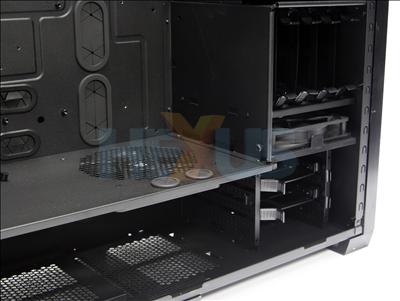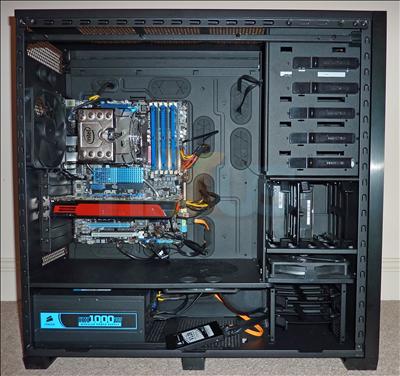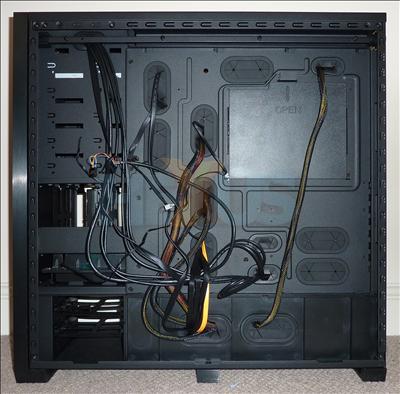Chassis tour II
A closer look at cooling zones one and two shows another 140mm fan by the watercooling grommets. It pulls air in from the bottom and pushes it towards the main compartment. The supplied fans - three in total - all have three-pin headers and whose speed, therefore, is controlled by the motherboard's BIOS settings.
The biggest difference in the Obsidian chassis, out goes the complicated and somewhat unnecesary hot-swap bays and in comes a regular four-bay compartment.
Completely tool-free in operation, the cages fasten on to the drives and then are 'squeezed' into the chassis. Cable routing can be pushed through the back and then via a rubber-covered section to the motherboard's SATA ports. Two further bays, this time rotated 90°, are positioned below the intake fan that serves as the jam in the fan drive-bay sandwich.
Corsair includes screws that enable 2.5in drives - SSDs, primarily - to be mounted without too much difficulty, but we'd like to see dedicated 2.5in bays appearing on the next iteration of Obsidian.
Move a little higher and the 5.25in bays come into view. Installation is also tool-free; the sliders are pushed to the right to secure the drive(s).
Here's our test system built into the 700D. An SSD has been left dangling at the bottom to show how the cables are routed through one rubber-covered hole and then emerge out of another.
Knocked-up in about 30 minutes from start to finish, this is about as messy a build as possible. The full-ATX ASUS P6X58D Premium motherboard looks diminutive in the cavernous chassis, which also has the correct markings for mini-ATX and eATX boards.
Beauty on the one side, here's the beastly aspect that you will never see if the side panel is on. Push enough cables through and the panel can begin to bulge somewhat, meaning that you will have to take care - more so than in this case - in arranging and flattening cables on the far side.
A larger cutout gives unfettered access to the back of the CPU socket. Installing coolers that require through-the-motherboard mounting is a cinch.
Corsair packages the 700D with an array of cable-ties, screws, SSD-mounting kits and a vibration dampener for the fan.










